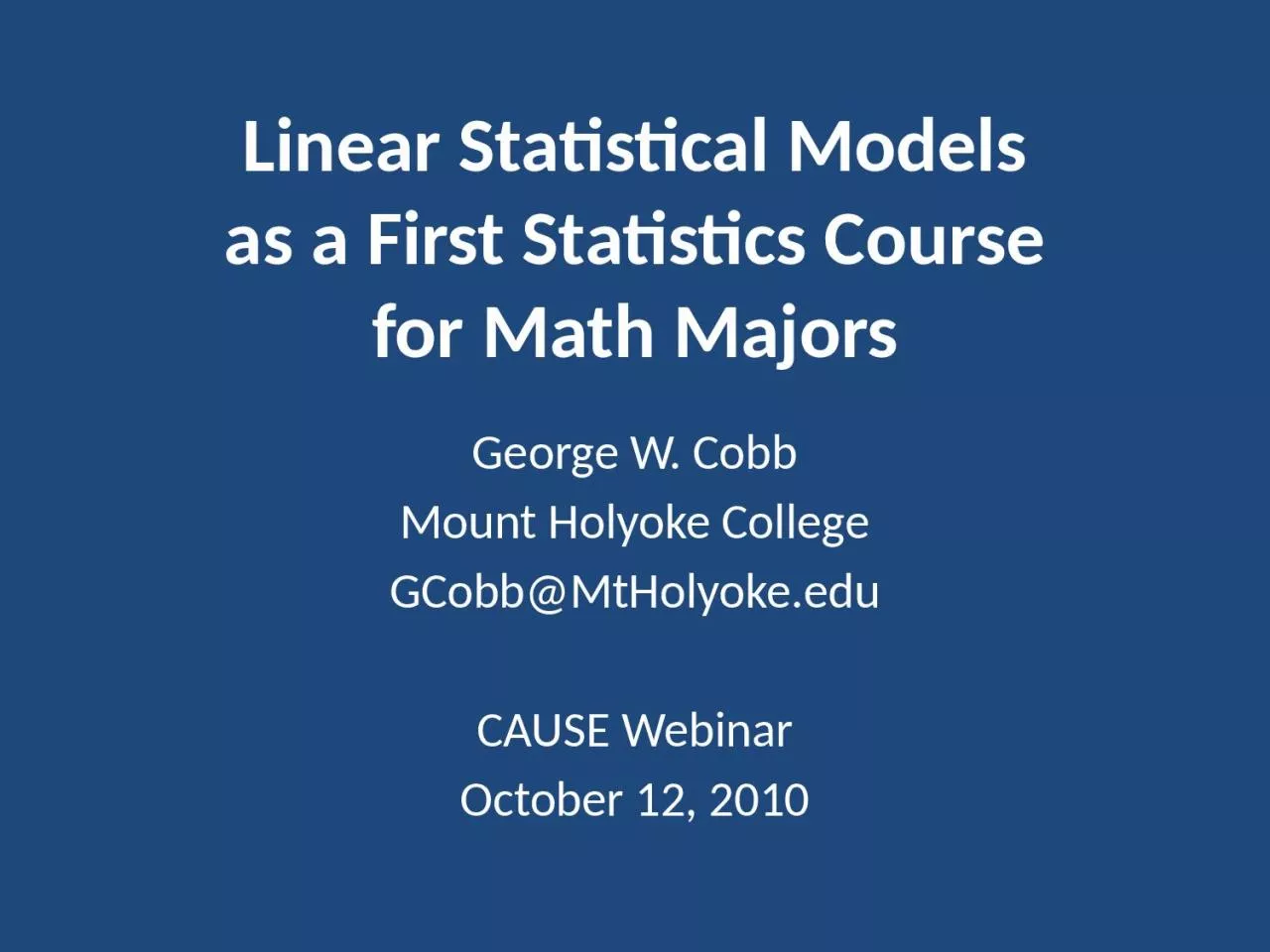

as a First Statistics Course for Math Majors George W Cobb Mount Holyoke College GCobbMtHolyokeedu CAUSE Webinar October 12 2010 Overview A Goals for a first stat course for math majors ID: 930302
Download Presentation The PPT/PDF document "Linear Statistical Models" is the property of its rightful owner. Permission is granted to download and print the materials on this web site for personal, non-commercial use only, and to display it on your personal computer provided you do not modify the materials and that you retain all copyright notices contained in the materials. By downloading content from our website, you accept the terms of this agreement.
Slide1
Linear Statistical Modelsas a First Statistics Coursefor Math Majors
George W. Cobb
Mount Holyoke College
GCobb@MtHolyoke.edu
CAUSE Webinar
October 12, 2010
Slide2OverviewA. Goals for a first stat course for math majors
B. Example of a modeling challenge
C. Examples of methodological challenges
D. Some important tensions
E. Two geometries
F. Gauss-Markov Theorem
G. Conclusion
Slide3A. Goals for a First Statistics Course for Math Majors :
1. Minimize prerequisites
2. Teach what we want students to learn
- Data analysis and modeling
- Methodological challenges
- Current practice
3. Appeal to the mathematical mind
- Mathematical substance
- Abstraction as process
- Math for its own sake
Slide4B. A Modeling Challenge:Pattern only – How many groups?
Slide5B. A Modeling Challenge:Pattern plus context: two lines?
Slide6B. A Modeling Challenge:Lurking variable 1: The five solid dots
Slide7B. A Modeling Challenge:Lurking variable 1: The five solid dots
Slide8B. A Modeling Challenge:Lurking variable 2 – confounding
Slide9B. A Modeling Challenge:Lurking variable 2 – confounding
Slide10B. A Modeling Challenge:Lurking variable 2 -- confounding
Slide11B. The Modeling Challenge: summary
Do the data provide evidence of discrimination?
Alternative explanations
based on classical economics
Additional variables:
percent unemployed in the subject
percent non-academic jobs in the subject
median non-academic salary in the subject
Which model(s) are most useful ?
Slide12C. Methodological ChallengesHow to “solve” an inconsistent linear system?
Stigler, 1990:
The History of Statistics
How to measure goodness of fit?
(Invariance issues)
How to identify influential points?
Exploratory plots
How
to measure
multicolinearity
?
Note that none of these require any assumptions about probability distributions
Slide13D. Some Important Tensions
Data analysis v. methodological challenges
Abstraction: Top down v. bottom up
Math as tool v. math as aesthetic object
Structure by dimension v. structure by assumptions
Distribution Number of covariates
assumptions One Two Many
A. None
B. Moments
C. Normality
5. Two geometries
Slide14D4. Structure by assumptions
No distribution assumptions about errors
1. Inconsistent linear systems; OLS Theorem
2. Measuring fit and correlation
3. Measuring influence and the Hat matrix
4. Measuring
multicolinearity
B. Moment assumptions: E{
e
}=
0
,
Var
{
e
}=
s
2
I
1. Moment Theorem: EV and
Var
for OLS estimators
2. Variance Estimation Theorem: E{MSE} =
s
2
3. Gauss-Markov
Theorm
: OLS = BLUE
C. Normality assumption: e ~
N
Slide15D4. Structure by assumptions
Normality assumption: e ~
N
1. Herschel-Maxwell Theorem
2. Distribution of OLS estimators
3. t-distribution and confidence intervals for
b
j
4. Chi-square distribution and confidence interval for
s
2
5. F-distribution and nested F-test
Slide16E. Two Geometries:the Crystal Problem (Tom Moore, Primus, 1992)
y
1
=
b
+
e
1
y
2
= 2
b
+
e
2
Slide17E. Two Geometries:
Crystal Problem
Individual Space Variable Space
Point = Case Vector = Variable
Axis = Variable Axis = Case
Slide18F
.
Gauss-Markov Theorem:
Crystal Example:
y
1
=
b
+
e
1
,
y
2
= 2
b
+
e
2
LINEAR:
estimator = a
1
y
1
+ a
2
y
2
UNBIASED:
a
1
b
+
a22b = b, i.e. a1 + 2a2 = 1.Ex: y
1
= 1
y
1
+ 0y2 a = (1,
0)TEx: (1/2)y
2
= 1
y
1
+
0
y
2
a
=
(0, 1/2)
T
Ex: (
1/5)
y
1
+
(2/5)
y
2
a
=
(1/5, 2/5)
T
BEST:
SD
2
(
a
T
y
) =
s
2
|
a
|
2
best = shortest
a
THEOREM: OLS = BLUE
Slide19F. Gauss-Markov Theorem:Coefficient Space for the Crystal Problem
Slide20F. Gauss-Markov Theorem:Estimator y1
= (1,0)(
y
1
,
y
2
)
T
B.
Slide21F. Gauss-Markov Theorem: Estimator y2
/2 = (0,1/2)(
y
1
,
y
2
)
T
B.
Slide22F. Gauss-Markov Theorem: OLS estimator = (1/5,2/5)(y1
,
y
2
)
T
B.
Slide23F. Gauss-Markov Theorem:The Set of Linear Unbiased Estimators
B.
Slide24F. Gauss-Markov Theorem:LUEs form a translate of error space
B.
Slide25F. Gauss-Markov Theorem:OLS estimator lies in model space
B.
Slide26F. Gauss-Markov Theorem:Four Steps plus Pythagoras
1. OLS estimator is an LUE
2. LUEs of
β
j are a flat set in
n
-space
3. LUEs of 0 = error space
4. OLS estimator lies in model space
Slide27G. Conclusion:A Least Squares Course can be
1. Accessible
- Requires only Calc. I and matrix algebra
2. A good vehicle for teaching data modeling
3. A sequence of methodological challenges
4. Mathematically attractive
- Mathematical substance
- Abstraction as process
- Math as tool
and
for its own sake
5. A direct route to current practice
- Generalized linear models
- Correlated data, time-to-event data
- Hierarchical
Bayes